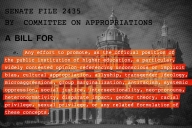You have /5 articles left.
Sign up for a free account or log in.
In recent years, many colleges have studied their histories, publicized their ties to slavery or segregation, and reconsidered symbols that strike critics as inappropriate for an era of inclusiveness. Statues have come down. Buildings have been renamed. New institutional histories have been published.
Washington and Lee University has not been immune. President George Washington provided an initial endowment for the college. Robert E. Lee was president of what was then Washington College from 1865, shortly after he surrendered his army, until 1870, when he died. As president, he led the college to financial stability and expanded the curriculum. His ideas are credited with the eventual development of the university's honor code. Shortly after he died, the board of the college changed the name of the institution to Washington and Lee. All presidents since Lee have lived in his house.
In 2014, the university apologized for having once owned slaves and said it would move Confederate flags near a statue of Lee in a chapel used for key university events. But if university leaders thought at the time that it had responsibly handled its history, they stopped thinking that last summer. The university has always promoted the view of Lee as flawed but worthy of honor. There has been more talk about his military genius and his work after the Civil War to promote reconciliation, and less talk about how he defended a system based on slavery, and participated in that system himself.
So with the initial calls in recent years for statues to come down, at Washington and Lee and elsewhere, Robert E. Lee wasn't the prime target. The University of Texas at Austin removed a statue of Jefferson Davis in 2015 but left a statue of Lee up until last year. Duke University also removed a Lee statue last year.
Both universities acted after last year's deadly white supremacist rally in Charlottesville, Va. -- organized on the premise of protesting the planned removal of a Lee statue in the city. While the statue in question was not at the University of Virginia, a march by white supremacists on campus featuring Nazi slogans stunned academics there and elsewhere.
Will Dudley, president of Washington and Lee, said in a statement following the violence in Charlottesville that "W&L and Lexington have a complex history with regard to the Confederate symbols and figures around which these hateful groups are rallying. Lee, our former president and one of our namesakes, has become a particularly polarizing figure. This gives us a special obligation to be absolutely clear about what we stand for as an institution." The university then appointed a panel to study the university's history and symbols -- with everything up for discussion, even the university's name.
That panel has now come forward with numerous recommendations that the university will now review. The panel suggests keeping the university name but making many other changes. Did the panel go too far or not far enough? It depends whom you ask, as the commission is already being criticized for (to some) unfairly diminishing Lee's legacy and (to others) continuing to glorify traditions that should be set aside.
A backdrop to the discussions is the reality that Washington and Lee has struggled to recruit black students -- despite a strong academic reputation and generous financial aid. Only 2 percent of Washington and Lee undergraduates are black, while 82 percent are white. The top liberal arts colleges with which W&L competes are far more diverse. At Davidson College, one state away, 7 percent of students are black and 68 percent are white.
The commission noted in its discussion of the university's name that "W&L's affiliation with its namesakes -- particularly R. E. Lee -- greatly limits the school's ability to attract diverse students, faculty and staff. This is a concern, as the school remains one of the least diverse liberal arts institutions in the nation."
What the Panel Recommended
The panel's report covers many parts of Washington and Lee, but much of the attention was on the university's name. The report included several reasons (including the impact on recruiting students) that would justify a name change.
But ultimately it opted to recommend keeping the name. "Changing the name would not change the institution's history or perfect its culture, and runs the risk of denying history rather than learning from it" was one reason the report gave for keeping the name.
And the report also stressed that keeping the name didn't need to equate with the status quo. "The recommendation to retain the name is not passive," the commission report said. "Rather, the commission thought that, at this point, efforts are better spent on concrete recommendations about how best to teach and present the university's history. At this time, the commission believes that W&L can maintain its namesakes while being a relevant, ethical and vibrant 21st-century institution."
The commission also recommended that W&L keep the Generals as its sports teams' name. The commission report noted significant disagreement on the commission and among those with whom its members consulted on this issue. Reasons the commission was urged to change the name include that both Washington and Lee became associated with the university after their military years. Further, "the team name is a vestige of a past era that accepted its association with the Civil War and celebrated its Confederate-cause identity," the commission said.
But the commission said it feared moving to change the name would divert attention from more important issues. And it added that the name "has longevity, popularity and a unifying effect. The name has been in place for decades and is immediately recognized by many university constituencies."
The commission did recommend a number of changes, including how Lee is viewed, however. The commission said that it was important for the university to acknowledge that Lee not only accepted slavery, but accepted the idea that the college he led would educate only white men. And the commission urged the university to teach about Lee's history (and the university's) including links to slavery, segregation and racism. And to put the emphasis on Lee's postwar career, the commission said the university should refer to him as "President Lee" not "General Lee."
Portraits and the Chapel
While keeping the university name, the commission urged W&L to think about all the ways that the campus focuses on Lee and Washington -- to the exclusion of others. Consider portraits. "As one scholar explains, portraits are powerful objects freeing many from the bonds of mortality," the report says. "The viewer's gaze brings the historical figure into the present day. Accordingly, the university should be aware of who is made present and why."
At Washington and Lee, 153 portraits are on display. Aside from those of 19 women, the rest are of white men. While the dominance of white men may be natural, given the university's history, the commission urges that portraits be added of black and female people with connections to the institution. And as for Lee, "only portraits of Lee that portray him in civilian attire, not as a Confederate general," should be displayed.
The image of Lee that the commission challenges most directly is in the Lee Chapel, which he recommended building and which has become both a place for key university events but also a memorial to him. The sculpture and other imagery in the chapel, the commission found, were part of an effort in the South in the late 19th century and beyond to make the Confederacy a great cause, worthy of veneration, and to make Confederate heroes into something akin to saints.
"By continuing to hold rituals and events in Lee Chapel, the university, wittingly or not, sustains the Shrine of the South and the memory of Lee as a commander of the Confederate Army," the report said. "The commission heard repeatedly in its outreach that the effect is problematic for many students, faculty, staff and alumni." Notably, the commission said, orientation of new students takes place in the chapel, as does the signing of the honor code.
So the commission is recommending that the chapel be converted to a museum, and that all key events be moved elsewhere.
And the commission recommended new efforts to recruit minority students and faculty members -- in part by being open about the university's history and desire to move beyond it, and in part by having university officials work together to promote diversity.
‘Only Scratch the Surface’
Stefani C. Evans, president of the Black Law Student Association at the university, said that the commission shouldn't have just recommended turning the chapel into a museum, but should have recommended the creation of another museum on the black experience at W&L. Generally, she said, while it was valuable to consider the full history of Lee and the university, the commission didn't go far enough in promoting a full history of the way black people have experienced the university.
"I believe that adopting all of the commission’s recommendations would only scratch the surface of the numerous issues faced by African-Americans and minorities at W&L, but it will not significantly change their experiences," Evans said via email. "If adopted in full, the commission’s report represents the first time W&L openly acknowledges that its portrayal of history on campus does not take into consideration the history, feelings, and concerns of African-American students and alumni. The implementation of all the commission’s recommendations is only the first step. Things will not get significantly better for African-Americans at W&L as long as the school continues to act as if African-Americans, their histories, contributions, concerns, and feelings are less important and secondary to those of others."
But articles that have run in The W&L Spectator, a conservative student publication, have questioned the way the commission treated Lee, arguing that the commission is "making a malicious and unrelenting assault on Robert E. Lee." Changing the way Lee is referred to (as something other than General Lee) or removing portraits of him in his Confederate uniform "are unnecessary and offensive to Robert E. Lee," one article said.
While the article said that students from all backgrounds should be encouraged to enroll at the university, the piece questioned the idea of creating new efforts to promote this. "The possibility of an appointed shadow government of diversity-minded central planners bent on artificially manipulating the ethnic makeup of the student body in order to fill a diversity quota should be viewed with suspicion," the article said.








